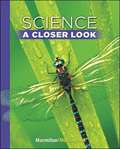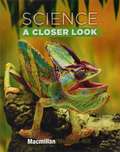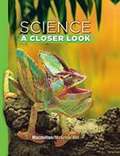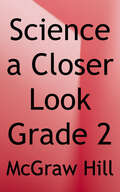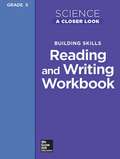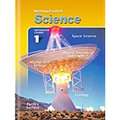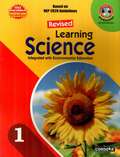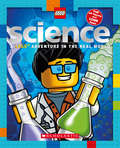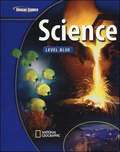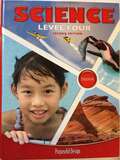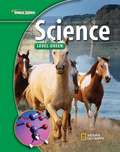- Table View
- List View
Science: A Closer Look
by Jay K. Hackett Richard H. Vasquez Joanne MoyerScience: A Closer Look, offers students exciting and accessible standards-based lessons. Engaging activities promote curiosity and foster the development of science inquiry skills. Through a consistent and structured learning cycle, students confidently build upon their experiences to develop a lifelong understanding of science concepts.
Science: A Closer Look
by Macmillan McGraw-HillThe Grade 4 Student Edition covers units such as Living Things, Ecosystems, Matter, and Forces of Energy.
Science: A Closer Look (Elementary Science Closer Look Series)
by McGraw HillThe Grade 2 Student Edition covers units such as Plants and Animals, Habitats, and Our Earth.
Science: A Closer Look (New Jersey Edition)
by Mcgraw-Hill GlencoeScience textbook for New Jersey schools
Science: A Closer Look (New York Edition)
by Jay K. Hackett Richard H. Moyer Joanne VasquezScience textbook for New York students.
Science: A Closer Look 2 (New York Edition)
by Dinah Zike Jay K. Hackett Richard H. Moyer Joanne Vasquez Mulugheta Teferi Kathryn LeroyTopics broadly covered in these book include: plants, animals, habitats, weather, earth, space, matter, forces, motion and energy.
Science: A Closer Look [Grade 5], Building Skills, Reading and Writing Workbook
by MacmillanA 5th grade science workbook that accompanies the textbook "Science a closer look" grade 5
Science: An Issues-Based Program (Grade 6 )
by University of California at Berkeley Lawrence Hall of ScienceIssues and Earth Science uses several kinds of activities to teach science. For example, you will observe and test the properties of soil, rocks, and minerals. You will examine a model of the way water moves earth materials to change the surface of the land. You will conduct a computer simulation to investigate the causes of earthquakes and volcanoes. A combination of experiments, readings, models, debates, role plays, and projects will help you uncover the nature of science and the relevance of science to your interests.
Science: An Issues-based Program (Grade #7)
by Manisha Hariani Sara Dombkowski Din SeaverScience textbook for 7th graders.
Science: Earth and Space
by Jeremy Foster Delores Shimmin Dawn Mckenzie Erica Martin Dewitt Steele Christine Hotke Greg ParkerScience textbook with a Christian perspective.
Science: Earth and Space
by Delores Shimmin Greg Parker DeWitt SteeleScience: Earth and Space has many features designed to make your study of earth and space science interesting and beneficial.
Science: Forces and Motion (Chapter 12A)
by Scott ForesmanScience 2006 Leveled Reader: Forces and Motion, Grade 3, Chapter 12 A by Scott Foresman
Science: Grade 6 Student Textbook
by Barbara Ferrier Timothy EimerThe following topics are covered in this grade level: Immune and Nervous Systems, Diversity of Life, Energy, Electricity, Matter, Weather, and Flight. Textbook includes: readings to reinforce the concepts presented in the classroom, numerous hands-on activities to enhance the lessons, colorful photographs, updated illustrations, graphs, and diagrams, a glossary of scientific terms (with pronunciation guides for more difficult words), questions to promote both recall and synthesis of ideas and concepts, and idebars with interesting information to enrich lessons. Text layouts have been updated to include colored tabs to easily differentiate units. Unit and chapter page numbers appear in the table of contents for quick reference.
Science: Integrated Course 1
by Mcdougal-Littell Publishing StaffIntegrated Science pulls together units from the different categories of science to give you a broad picture of how scientists study nature.
Science: Integrated With Environmental Education class 1
by Dhiren M DoshiCordova Learning Series-Science for classes 1 and 2 is strictly written according to the guidelines recommended in the latest National Curriculum Framework suitable for CBSE, ICSE and other State Board Schools. The main objective of this series of Science is to provide students a clear and logical presentation of the subject so as to develop: Scientific Concepts and Fundamentals and their application in solving the problems in their day-to-day lives. Scientific Skills like Observation, Enquiring, Performing Hands-on Activities and Experiments, Recording and Communicating Information. Scientific Attitude and Temperament.
Science: LEGO Nonfiction
by Penelope Arlon<p>Did you know that the blue whale could blow up 1,250 balloons in a single breath? Or that the Earth's core is as hot as the surface of the sun? <p>Including information about almost every scientific topic in the universe, readers will find out everything they ever wanted to know about fascinating animals, electricity, energy, weather, our galaxy, technology of tomorrow, and so much more. They'll even meet real-life scientists and read all about their exciting work. Complete with hundreds of stunning photographs, fun facts, mini comics, and building ideas, LEGO Science is the perfect book for young readers curious about science. Includes a buildable scientist minifigure! <p>This is a fixed-format ebook, which preserves the design and layout of the original print book.</p>
Science: Level Blue
by Glencoe/McGraw-HillWith a broad array of innovative print and technology resources, "Glencoe Science" helps teachers differentiate and accommodate all learners! The range of labs, content area reading, discussion strategies, note-taking tools, and activities provides students with multiple experiences of each Science Standard. They give teachers flexibility and the ability to monitor student progress through ongoing assessment. .
Science: Level Four
by Purposeful Design Publications Various RolesScience level four by Purposeful Design... The world you live in is amazing in it's beauty, complexity, and order! Science lets you explore and learn about how things are made and how they work. God designed you to be inquisitive. God wants you to see Kim! Jeremiah 29:13 "You will seek me and find me when you seek me with all your heart"
Science: Level Green
by Glencoe/McGraw-HillTry this new Integrated Science program that features a balance of inquiry and content.
Science: Life, Physical, Earth And Space (Science Series)
by Steck-Vaughn StaffSteck-Vaughn Second Grade Science features over 140 activities across earth & space science, life science, and physical science. Background information, cross-curricular activities, projects, experiments, and assessments are provided, along with a line-listed answer key in the back. 176 pages, reproducible for home/classroom use. 2nd Grade.
Science: Matter and Energy
by Jeremy Foster Delores Shimmin Dewitt Steele Gregory ParkerPrepare your child for chemistry and physics through the foundational principles taught in Science: Matter and Energy. Start out with scientific measurements and the different forms of matter and graduate into the foundations of chemical reactions and properties of magnets and electricity. With proofs for Creation, section and chapter reviews, and over 500 pictures, charts, and graphs, your child will be able to smoothly transition into chemistry from his study of Science: Matter and Energy.
Science: Matter and Energy Lab Manual
by Foster; Bunch; Kim; SochVisually reinforce a concept with the Science: Matter and Energy Laboratory Manual. Correlated with the topics contained in Science: Matter and Energy, this manual presents 29 regular labs plus optional appendix labs covering a variety of topics from science investigation and engineering design to physics and chemistry. With each lab, we’ve included a materials supply list, detailed step-by-step instructions, report sheets, and critical thinking questions. Your students will be thrilled to learn with these fun and instructional demonstrations.
Science: Matter and Energy Laboratory Manual
by Jeremy Foster Tom Stone Dewitt Steele Gregory Parker Brian Mcdivitt Verne Biddle Barbara PorcherReinforce concepts taught in class with the 36 demonstrations in this Laboratory Manual. These labs are designed for the teacher to perform the demonstration with assistance from the child. Study volume, density, buoyancy, levers, magnetization, electric circuits and more with the hands on activities specifically detailed in these demonstrations. Each lab comes complete with a stated purpose, introduction, equipment list, instructions, and lab sheet for reporting results. Bring chemistry and physics concepts to life with this Laboratory Manual.
